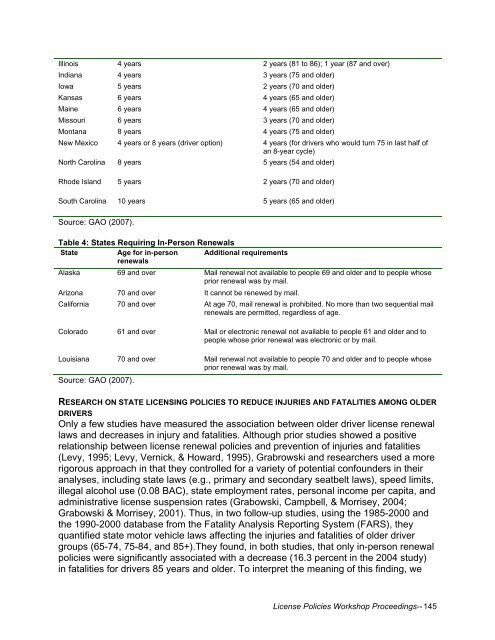Workshop Proceedings - AAA Foundation for Traffic Safety
Workshop Proceedings - AAA Foundation for Traffic Safety
Workshop Proceedings - AAA Foundation for Traffic Safety
Create successful ePaper yourself
Turn your PDF publications into a flip-book with our unique Google optimized e-Paper software.
Illinois 4 years 2 years (81 to 86); 1 year (87 and over)<br />
Indiana 4 years 3 years (75 and older)<br />
Iowa 5 years 2 years (70 and older)<br />
Kansas 6 years 4 years (65 and older)<br />
Maine 6 years 4 years (65 and older)<br />
Missouri 6 years 3 years (70 and older)<br />
Montana 8 years 4 years (75 and older)<br />
New Mexico 4 years or 8 years (driver option) 4 years (<strong>for</strong> drivers who would turn 75 in last half of<br />
an 8-year cycle)<br />
North Carolina 8 years 5 years (54 and older)<br />
Rhode Island 5 years 2 years (70 and older)<br />
South Carolina 10 years 5 years (65 and older)<br />
Source: GAO (2007).<br />
Table 4: States Requiring In-Person Renewals<br />
State Age <strong>for</strong> in-person<br />
renewals<br />
Additional requirements<br />
Alaska 69 and over Mail renewal not available to people 69 and older and to people whose<br />
prior renewal was by mail.<br />
Arizona 70 and over It cannot be renewed by mail.<br />
Cali<strong>for</strong>nia 70 and over At age 70, mail renewal is prohibited. No more than two sequential mail<br />
renewals are permitted, regardless of age.<br />
Colorado 61 and over Mail or electronic renewal not available to people 61 and older and to<br />
people whose prior renewal was electronic or by mail.<br />
Louisiana 70 and over Mail renewal not available to people 70 and older and to people whose<br />
prior renewal was by mail.<br />
Source: GAO (2007).<br />
RESEARCH ON STATE LICENSING POLICIES TO REDUCE INJURIES AND FATALITIES AMONG OLDER<br />
DRIVERS<br />
Only a few studies have measured the association between older driver license renewal<br />
laws and decreases in injury and fatalities. Although prior studies showed a positive<br />
relationship between license renewal policies and prevention of injuries and fatalities<br />
(Levy, 1995; Levy, Vernick, & Howard, 1995), Grabrowski and researchers used a more<br />
rigorous approach in that they controlled <strong>for</strong> a variety of potential confounders in their<br />
analyses, including state laws (e.g., primary and secondary seatbelt laws), speed limits,<br />
illegal alcohol use (0.08 BAC), state employment rates, personal income per capita, and<br />
administrative license suspension rates (Grabowski, Campbell, & Morrisey, 2004;<br />
Grabowski & Morrisey, 2001). Thus, in two follow-up studies, using the 1985-2000 and<br />
the 1990-2000 database from the Fatality Analysis Reporting System (FARS), they<br />
quantified state motor vehicle laws affecting the injuries and fatalities of older driver<br />
groups (65-74, 75-84, and 85+).They found, in both studies, that only in-person renewal<br />
policies were significantly associated with a decrease (16.3 percent in the 2004 study)<br />
in fatalities <strong>for</strong> drivers 85 years and older. To interpret the meaning of this finding, we<br />
License Policies <strong>Workshop</strong> <strong>Proceedings</strong>-- 145








